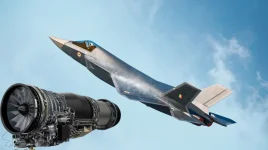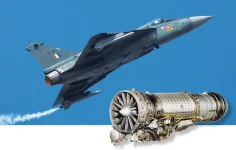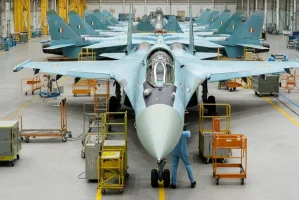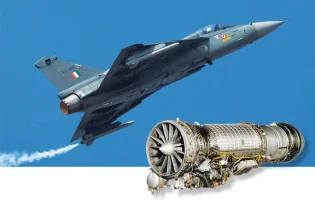- Views: 4K
- Replies: 20
India's domestically developed Light Combat Aircraft (LCA) Tejas Mk1A is emerging as a highly advanced asset for the Indian Air Force (IAF).
Equipped with stealth characteristics, a state-of-the-art radar system, and long-range missiles, the aircraft is positioned to offer a significant tactical advantage over established fighters in the IAF's fleet, such as the French Mirage-2000 and the Russian-made Su-30MKI, particularly in beyond-visual-range combat.
The Tejas Mk1A is engineered around a core principle of modern aerial warfare: "see first, shoot first." This strategy is enabled by its combination of a low radar signature, a powerful Active Electronically Scanned Array (AESA) radar, and the formidable Astra Mk2 air-to-air missile.
This blend of technologies allows the Tejas Mk1A to detect and engage enemy aircraft from a distance, long before it can be detected itself, reshaping India's air superiority doctrine against regional challenges.
A New Generation of Indian Air Power
Developed by Hindustan Aeronautics Limited (HAL) and the Aeronautical Development Agency (ADA), the Tejas Mk1A is a 4.5-generation multi-role combat aircraft.It represents a major leap over the initial Mk1 version, with the IAF having placed an order for 83 of these upgraded jets. Its superiority in specific scenarios stems from four critical areas: its stealth profile, advanced radar, long-range weaponry, and integrated electronic defence systems.
The Advantage of a Smaller Radar Footprint
A crucial feature of the Tejas Mk1A is its exceptionally low Radar Cross-Section (RCS), which measures how visible an aircraft is to enemy radar.With an estimated frontal RCS between 0.1 and 0.5 square metres, it is significantly stealthier than both the Mirage-2000 (approx. 1–2 m²) and the much larger Su-30MKI (estimated at 10–20 m²).
This low visibility is achieved through several design features:
- Compact Airframe: The Tejas’s small, delta-wing design naturally presents a smaller target for radar waves.
- Advanced Materials: Nearly 45% of the aircraft’s surface is made of composite materials that absorb radar energy instead of reflecting it.
- Aerodynamic Shaping: The aircraft's smooth fuselage and aligned edges are designed to deflect radar waves away from their source, making detection difficult.
Superior Vision with AESA Radar Technology
The Tejas Mk1A is being fitted with an advanced AESA radar, initially the Israeli EL/M-2052, which will be followed by the indigenous Uttam AESA radar from the 41st aircraft onwards.Developed by India's Defence Research and Development Organisation (DRDO), the Uttam radar provides a decisive advantage in situational awareness.
Unlike the mechanically scanned radars of the Mirage-2000 (RDY-2) and Su-30MKI (N011M Bars), the Uttam AESA can:
- Track Multiple Targets: It can simultaneously track up to 50 targets and engage several at once.
- Detect from a Longer Range: It can detect modern fighter aircraft from distances exceeding 200 km.
- Resist Jamming: AESA technology is highly resistant to enemy electronic countermeasures, ensuring operational reliability.
Long-Range Strike with the Astra Missile
The integration of the indigenous Astra Mk2 Beyond Visual Range Air-to-Air Missile (BVRAAM) completes the Tejas Mk1A's "shoot first" capability.With a reported range of over 160 km, the Astra Mk2 significantly outranges the Mirage-2000's MICA missile (80–100 km) and offers a competitive edge against the Su-30MKI's R-77 missiles (110–150 km).
Developed by DRDO, the Astra missile travels at a speed of Mach 4.5 and uses sophisticated guidance systems to ensure a high probability of hitting its target.
This combination of the Tejas's stealth, the AESA radar's long-range detection, and the Astra's extended reach allows the IAF to neutralize aerial threats from a safe distance.
Advanced Electronic Defence and Strategic Relevance
To enhance its survival in hostile environments, the Tejas Mk1A is equipped with a modern Unified Electronic Warfare (UEWS) suite. This system can detect and jam enemy radar and missile guidance systems, providing a robust layer of self-protection.This integrated and modern system is considered more advanced than the systems on the older Mirage-2000 and more compact than those on the Su-30MKI.
This combination of capabilities makes the Tejas Mk1A particularly well-suited to counter emerging regional threats, such as low-flying cruise missiles like Pakistan's Fatah series.
Its ability to look down with powerful radar and engage small, fast-moving targets is a key asset for national air defence.
Furthermore, by demonstrating cutting-edge indigenous military technology, the successful deployment of the Tejas Mk1A serves as a powerful counter to disinformation campaigns regarding India's operational readiness.




